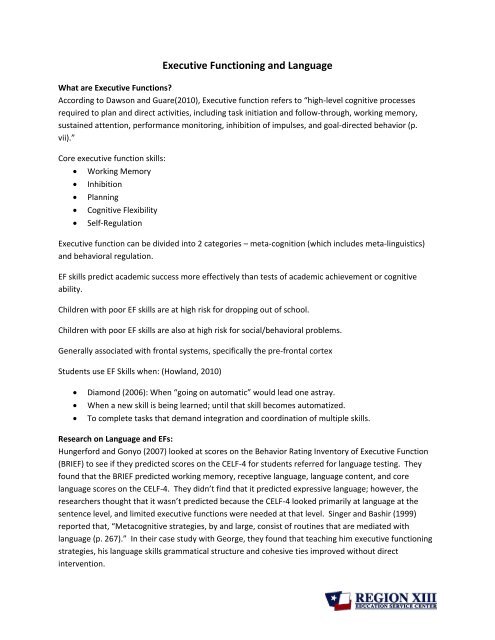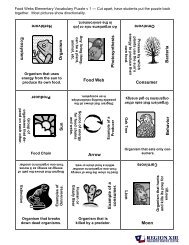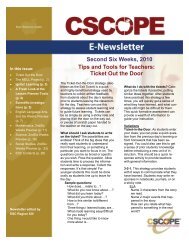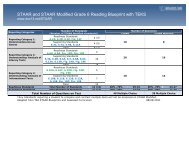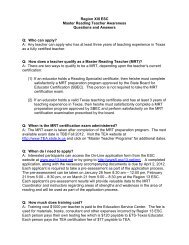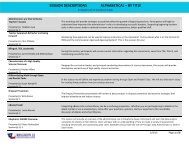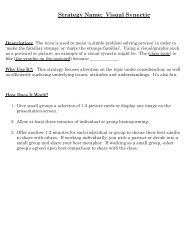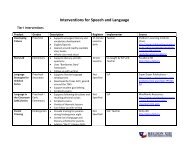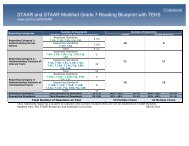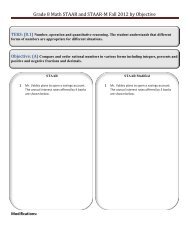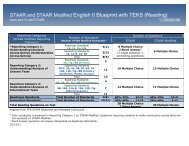Executive Functioning and Language
Executive Functioning and Language
Executive Functioning and Language
- No tags were found...
Create successful ePaper yourself
Turn your PDF publications into a flip-book with our unique Google optimized e-Paper software.
<strong>Executive</strong> <strong>Functioning</strong> <strong>and</strong> <strong>Language</strong>What are <strong>Executive</strong> Functions?According to Dawson <strong>and</strong> Guare(2010), <strong>Executive</strong> function refers to “high-level cognitive processesrequired to plan <strong>and</strong> direct activities, including task initiation <strong>and</strong> follow-through, working memory,sustained attention, performance monitoring, inhibition of impulses, <strong>and</strong> goal-directed behavior (p.vii).”Core executive function skills:Working MemoryInhibitionPlanningCognitive FlexibilitySelf-Regulation<strong>Executive</strong> function can be divided into 2 categories – meta-cognition (which includes meta-linguistics)<strong>and</strong> behavioral regulation.EF skills predict academic success more effectively than tests of academic achievement or cognitiveability.Children with poor EF skills are at high risk for dropping out of school.Children with poor EF skills are also at high risk for social/behavioral problems.Generally associated with frontal systems, specifically the pre-frontal cortexStudents use EF Skills when: (Howl<strong>and</strong>, 2010)Diamond (2006): When “going on automatic” would lead one astray.When a new skill is being learned; until that skill becomes automatized.To complete tasks that dem<strong>and</strong> integration <strong>and</strong> coordination of multiple skills.Research on <strong>Language</strong> <strong>and</strong> EFs:Hungerford <strong>and</strong> Gonyo (2007) looked at scores on the Behavior Rating Inventory of <strong>Executive</strong> Function(BRIEF) to see if they predicted scores on the CELF-4 for students referred for language testing. Theyfound that the BRIEF predicted working memory, receptive language, language content, <strong>and</strong> corelanguage scores on the CELF-4. They didn’t find that it predicted expressive language; however, theresearchers thought that it wasn’t predicted because the CELF-4 looked primarily at language at thesentence level, <strong>and</strong> limited executive functions were needed at that level. Singer <strong>and</strong> Bashir (1999)reported that, “Metacognitive strategies, by <strong>and</strong> large, consist of routines that are mediated withlanguage (p. 267).” In their case study with George, they found that teaching him executive functioningstrategies, his language skills grammatical structure <strong>and</strong> cohesive ties improved without directintervention.
To learn more about EFs in adolescents with SLI, Hughes, Turkstra, <strong>and</strong> Wulfeck (2008) administered theBRIEF-SR to adolescents with <strong>and</strong> without SLI, <strong>and</strong> compared scores between these two groups <strong>and</strong> alsoto parents' scores on the BRIEF Parent-Report Form. Results showed that parent <strong>and</strong> self-ratings of EFproblems in everyday life were significantly higher for adolescents with SLI (i.e., indicating moreproblems) than for peers matched for age, sex, <strong>and</strong> race. In addition, in the SLI group, 57% of parentratings were in the clinically impaired range, compared to 10% in the typical group.Further, anecdotal comments from parents of adolescents with SLI revealed that EF-related problemswere their main concern; worries about their children's ability to use communication skills effectively insocial interactions, live independently, <strong>and</strong> obtain competitive employment far outnumbered theirconcerns about formal language skills. Although there continues to be debate about the underlying basisof EF problems in adolescents with language impairments (Booth, Boyle, & Kelly, 2010), these datasuggest that EFs should be considered in intervention planning for this group.Results suggest that SLI children: (Tropper, B. et al., 2008).Have more difficulty controlling behavioral responses under high levels of conflictAre poorer in monitoring/detecting conflict.High frequency of perseveration;Weak resistance to interference;Problems with expelling unnecessary material from working memory.Impaired selective attention abilities, resulting in less efficient language processing in thepresence of distraction.<strong>Executive</strong> function skills, not languages skills predicted social skills for students with languageimpairments. (Hungerford, Call-Morin, Bassendowski, <strong>and</strong> Whitford, 2009)Intervention Skills: What to TargetPre-School-1st gradeInhibition2nd-5th gradePlanning through Play/Center TimesDevelop Strategy UseGraphic OrganizersSelf-Regulation of AttentionMiddle School <strong>and</strong> High SchoolIndependent <strong>and</strong> Flexible Strategy UsePlanning/prioritizing/OrganizingBeing systematicSelf -regulation/self-monitoringSelf-advocacy
Games to Develop Inhibition in Preschoolers (Howl<strong>and</strong>, 2010)Duck Duck GooseFreeze TagSimon Says (simplify for the younger child, do what the “good puppet” says, not what the“naughty puppet” says).Slap (Tap) Jack (we do this with letters)Musical Chairs Mother May I?References:Booth, J. N., Boyle, J. M., & Kelly, S. W. (2010). Do tasks make a difference? Accounting for heterogeneityof performance of children with reading difficulties on tasks of executive function: findings from a metaanalysis.British Journal of Developmental Psychology, 28(Pt 1), 133-176Dawson, P. <strong>and</strong> Guere, R. (2010). <strong>Executive</strong> Skills in Children <strong>and</strong> Adolescents: A Practical Guide toAssessment <strong>and</strong> Intervention. New York: Guilford Press.Howl<strong>and</strong>, K. (2010). Strategies to Develop <strong>Executive</strong> Control Skills in <strong>Language</strong>-Impaired Children. Paperpresented at the American Speech <strong>Language</strong> Hearing Association Conference, 2010.Hughes, D. M., Turkstra, L. S., & Wulfeck, B. B. (2008). Parent <strong>and</strong> self-ratings of executive function inadolescents with specific language impairment. International Journal of <strong>Language</strong> <strong>and</strong> CommunicationDisorders, 1-16.Hungerford, S., Call-Morin, K., Bassendowski, N., Whitford, S. (2009). Do <strong>Executive</strong> Skills or <strong>Language</strong>Skills Best Predict Social Competence? Paper presented at the American Speech <strong>Language</strong> HearingAssociation Conference, 2009.Hungerford, S. <strong>and</strong> Gonyo, K. (2007). Relationships Between <strong>Executive</strong> Functions <strong>and</strong> <strong>Language</strong>Variables. Paper presented at the American Speech <strong>Language</strong> Hearing Association Conference, 2007.Singer, B.D. & Bashir, A.S. (1999). What are executive functions <strong>and</strong> self-regulation <strong>and</strong> what do theyhave to do with language learning disorders? <strong>Language</strong>, Speech <strong>and</strong> Hearing Services in Schools, 30, pp.256-273.Tropper, B., Marton, K., Russo-Victorino, K., Shafer, V., Schwartz, R.G. (2008). Research on <strong>Executive</strong>Functions in Children with SLI. Paper presented at the American Speech <strong>Language</strong> Hearing AssociationConference, 2008.


